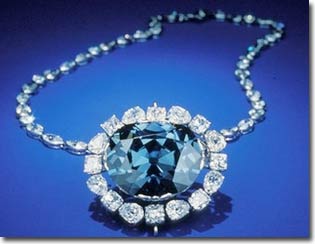UV rays help identify blue diamonds
The famous Hope diamond emitted a mysterious red light when illuminated with ultraviolet rays. Scientists say this finding helps them distinguish natural and artificial blue diamonds.
According to Jeffrey Port - in charge of the National Gem Collection at Smithsonian National Museum of History - phosphorescent rays created by Bo element in diamond. This same element makes it blue under normal light.
Although all blue diamonds glow under the influence of ultraviolet light, they all have green light. Only Hope members have red light. Mr. Post explained through an interview on the phone, showing that the diamond has a different blend of Bo and Nitrogen.

Hope diamond on display in Washington (Photo: AP)
According to him, by delimiting the different emitted light of diamonds scientists can still distinguish true fake and distinguish between real diamonds and those that have been ' upgraded ' in the laboratory . The study was conducted at the Smithsonian and Naval research labs. The results are published in Geology.
Some historians believe that the Hope diamond was cut from a larger gem found for the first time in India, after which it was used to dress the French palace before the revolution. France broke out.
According to Mr. Post, if true, this test can be used to identify different gems of the same origin.
The 45.52 carat Hope diamond is currently on display at the Natural History Museum, but the lighting conditions there make it impossible to change color when exposed to ultraviolet light. Post said, the museum hopes to be able to shoot the shining diamond for visitors to admire. This phenomenon has continued many times when the lights are off.
'People simply treat the Hope diamond as a gemstone, but the study emphasizes its role as an extremely rare scientific specimen in order to provide essential knowledge about diamonds and creation. their city on the earth '.
Prior to this study, there was only one scientific study that had been conducted on the properties of phosphorescence in natural blue diamonds. Because it is extremely rare and valuable, scientists have had to use rhinestones in that study. Post and his colleagues took advantage of their unique opportunity to study the museum's huge collection of natural blue diamonds thanks to diamond dealers.
- Discovered a huge blue diamond in South Africa
- Found blue diamonds in South Africa
- Discovering a blue diamond
- Precious blue diamonds are created from ancient oceans
- Find the world's largest 3 billion year old diamond
- Mystical curse from the gems
- Discover 2 diamonds larger than 100 carats in South Africa
- Learn about diamonds and how to recognize real diamonds
- Artificial diamonds cut everything in nature
- Digging the largest second-largest diamond, extremely expensive
- Russia develops counterfeit diamond solution
- How to create pure diamonds like natural diamonds in 2 weeks
 'Barefoot engineer' invents a pipeless pump
'Barefoot engineer' invents a pipeless pump Process of handling dead pigs due to disease
Process of handling dead pigs due to disease Radiometer
Radiometer Warp Engine: Technology brings us closer to the speed of light
Warp Engine: Technology brings us closer to the speed of light